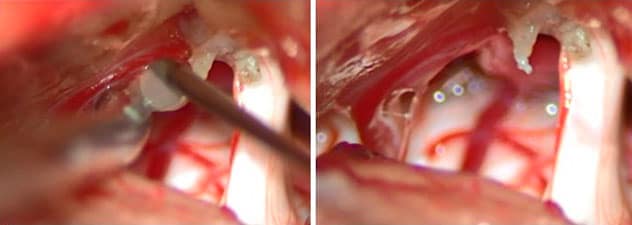June 24, 2022
عملية تخفيف الضغط على الأوعية الدموية الدقيقة باستخدام الفبرين

عملية تخفيف الضغط على الأوعية الدموية الدقيقة باستخدام الفبرين
تُظهر الصورة اليسرى وضع الفبرين لحماية الأوعية الدموية المسببة للمشكلات. وتوضح الصورة اليمنى عملية تخفيف الضغط على الأوعية الدموية الدقيقة من دون استخدام التفلون.
Mayo Clinic uses a novel surgical technique to treat trigeminal neuralgia. The procedure involves transposing the offending blood vessel onto the dura with fibrin, rather than performing microvascular decompression with Teflon.
"Our procedure avoids leaving nonbiologic material in contact with the patient's trigeminal nerve or other intracranial structures. We believe that this method can avoid complications associated with microvascular decompression — principally, the recurrence of pain," says Richard S. Zimmerman, M.D., a neurosurgeon at Mayo Clinic in Phoenix/Scottsdale, Arizona.
A study of individuals who had Mayo Clinic's transposition procedure found that 89.4% of study participants remained pain-free at a maximum follow-up of 17 years. As described in the April 2021 issue of Operative Neurosurgery, that percentage is on the high end of pain-free rates reported in studies of conventional microvascular decompression.
Mayo Clinic developed the fibrin procedure after seeing individuals who had microvascular decompression at other centers and experienced recurrent trigeminal neuralgia.
"In our experience, Teflon becomes noncompliant and rigid, with glial scarring over time," Dr. Zimmerman says. "The underlying goal of microvascular decompression is to remove pressure from the affected nerve, and that can be accomplished with fibrin."
Potential learning opportunity
Trigeminal neuralgia is associated with a significant patient burden, including decreased quality of life. An estimated 1,600 microvascular decompressions a year are performed in the United States to treat trigeminal neuralgia.
The most common technique is to place Teflon between the offending vessel and the trigeminal nerve. According to long-term follow-up studies, between 32% and 83% of individuals who have the procedure don't experience recurrent pain.
"The proper use of Teflon can control trigeminal neuralgia symptoms," Dr. Zimmerman says. "But the essence of performing microvascular dissection is to remove pressure from the affected nerve, not to place Teflon between the vessel and nerve."
Dr. Zimmerman notes that suboptimal teaching of residents may be a factor. "Performing microvascular decompression has been oversimplified to simply placing — or even stuffing —Teflon between the nerve and vessel, without a focus on decompression," he says.
Mayo Clinic's technique uses less than 1 milliliter of fibrin to attach the aberrant vessel to the cerebellar tentorium or petrous dura.
"Our study results demonstrate that the procedure is effective at preventing pain recurrence long after the procedure is performed," Dr. Zimmerman says.
For more information
Pines AR, et al. Microvascular transposition without Teflon: A single institution's 17-year experience treating trigeminal neuralgia. Operative Neurosurgery. 2021;20:397.
Refer a patient to Mayo Clinic.